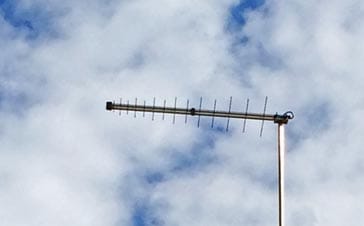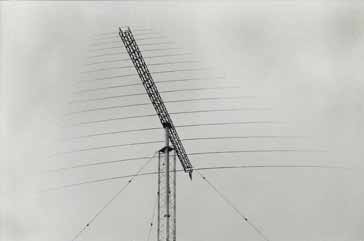Log Periodic Antenna / Aerial
The log periodic antenna or aerial often called the LPDA is a wideband directional antenna that provides gain and directivity combined over a wide band of frequencies.
Log periodic antenna includes:
Log periodic antenna basics
Log periodic theory & equations
Directive antennas like the Yagi provide gain and directivity but their bandwidth is limited.
One form of antenna that is able to provide gain and directivity along with a wide bandwidth is known as the log periodic antenna. Although larger than an equivalent Yagi or other directive design for an equivalent level of gain, it provides the capability to operate on many different frequencies.

The log periodic antenna was initially developed by Dwight E. Isbell, Raymond DuHamel who published a paper in 1957 later additional variants were made by Paul Mayes. The concept of the log periodic antenna was patented by the University of Illinois in the USA.
Log periodic antenna types & variants
There are several forms of log periodic antenna. The exact type that is most applicable for any given application will depend upon the requirements.
The main types of log periodic antenna include:
- Log periodic dipole array, LPDA
- Slot log periodic
- Zig zag log periodic array
- Trapezoidal log periodic
- V log periodic
The type that is most widely used is the log periodic dipole array, LPDA, and that will be described here.

Log periodic dipole array basics
The log periodic dipole array consists of a number of dipole elements. These progressively reduce in size from the back to the front – the direction of maximum radiation is from the smaller front.
Each dipole element of the LPDA is fed, but the phase is reversed between adjacent dipole elements – this ensures that the signal phasing is correct between the different elements. It also means that a feeder is required along the length of the antenna. Normally this is arranged so that it forms part of the mechanical structure of the array.
Not all the antenna array is active at any given frequency. The active region, i.e. the sections of the antenna that are contributing to the transmission or reception vary with frequency, and only about three may really contribute to the radiation at any given frequency. There is also a smooth transition of the active region of the LPDA along the array as the frequency of operation changes.
The element at the back of the array where the elements are the largest is a half wavelength at the lowest frequency of operation - the longest element acts as a half wave dipole at the lowest frequency. The element spacing also decrease towards the front of the array where the smallest elements are located. The upper frequency is a function of the length of the shortest element.

There is also normally a shorted matching feeder stub attached to the end of the feeder furthest from the shortest element to ensure that the required match is provided to the antenna feeder and along the feed line in the antenna.
Log periodic antenna performance
The log periodic dipole array, LPDA is generally able to operate over a frequency range of around 2:1 and provide forward gain over a dipole.
Like the Yagi antenna it exhibits forward gain and has a high front to back ratio, but the LPDA is able to operate over a much wider bandwidth and will have a lower gain for an equivalent number of elements.
In operation the radiation pattern of the LPDA design remains broadly the same over the whole of the operating band. In addition to this parameters like the radiation resistance and reflected power as indicated by the standing wave ratio.
In terms of its specification a typical log periodic antenna might provide between 3 and 6 dB gain over dipole for a bandwidth of 2:1 while retaining an VSWR level of better than 1.3:1. With this level of performance it is ideal for many applications, although a log periodic antenna will be much larger than a Yagi of equivalent gain.
Log periodic antenna applications
The log periodic antenna is used in many areas wide bandwidth levels are needed along with directivity and gain. There are several areas where the antenna is used:
- HF communications: Log periodic antenna arrays are often used for diplomatic traffic on the HF bands. Log periodic antennas perform well because embassies and other similar users will need to operate over a wide selection of frequencies in the HF bands, and it is often only feasible to have one antenna. A single log periodic antenna will give access to a sufficient number of frequencies over the HF bands to enable communications to be made despite the variations in the ionosphere changing optimum working frequencies.
- UHF Terrestrial TV: The log periodic antenna is sometimes used for UHF terrestrial television reception. As television channels may be located over a wide portion of the UHF spectrum, the log periodic enables a sufficient bandwidth to be covered.
- EMC measurements: EMC is a key issue for all electronic products. Testing requires frequency scans to be undertaken over wide bands of frequencies. When testing for radiated emissions an antenna that is able to provide a flat response over a wide band of frequencies is needed. The log periodic is able to offer the performance required and is widely used in this form of application.
- Other applications: There are many other applications where log periodic antennas can be used. Any applications where directivity and a wide bandwidth are needed are ideal applications for this form of RF antenna design.
In view of its size and lower gain than the Yagi, the log periodic dipole array tends not be used as widely as the Yagi. Yet the LPDA comes into its own when wide bandwidths are needed.
More Antenna & Propagation Topics:
EM waves
Radio propagation
Ionospheric propagation
Ground wave
Meteor scatter
Tropospheric propagation
Antenna basics
Cubical quad
Dipole
Discone
Ferrite rod
Log periodic antenna
Parabolic reflector antenna
Phased array antennas
Vertical antennas
Yagi
Antenna grounding
Installation guidelines
TV antennas
Coax cable
Waveguide
VSWR
Antenna baluns
MIMO
Return to Antennas & Propagation menu . . .



